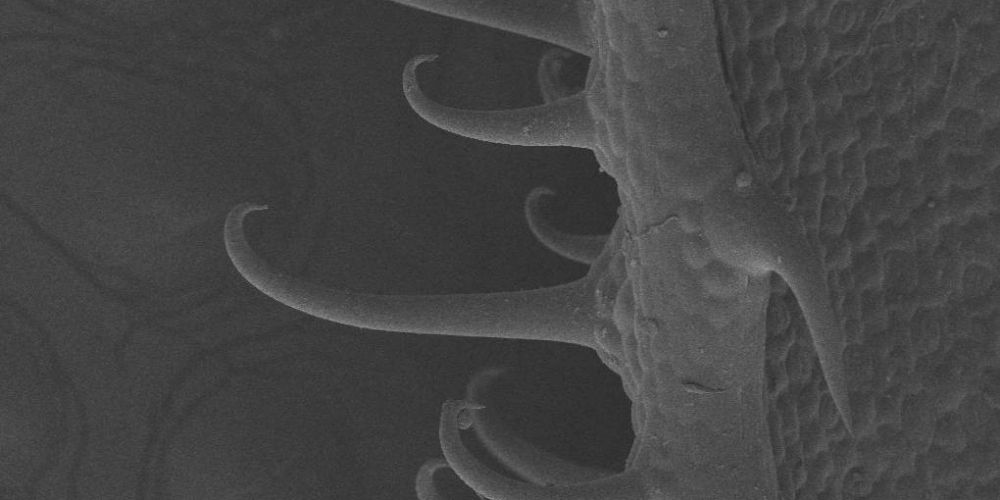
The Italian Institute of Technology (IIT) has created the very first prototype of a biodegradable and soluble ‘velcro plaster’ that was inspired by climbing plants. The Institute has transformed the structure of micro-hooks from this plant into an artificial type of band-aid that is especially useful for precision agriculture. The research was published (lead author: Sabella Fiorello) in “Communications Materials,” an open access scientific publication that is part of the Nature journal group. We spoke with Barbara Mazzolai (53), head of the Bio-inspired Soft Robotics Lab at IIT.

Why did you decide to take climbing plants as a basis for research?
“The interesting thing about a climbing plant is that it does not tend to grow from a robust stem, but mainly uses its energy to grow towards the light as quickly as possible. To avoid collapsing under its own weight, the plant grabs onto anything and everything. The strategy for attaching itself is predicated on very small hooks, which grab or stick to anything that comes its way. In particular, we have studied the adhesive system of galium aparine, also known as catchweed. This is a seemingly inconspicuous plant that, nevertheless, has this kind of adhesive system like no other climbing plant has.”
How did you come up with this artificial ‘velcro’?
“We examined the plant’s natural microhooks for both their shape and their biomechanical characteristics to such an extent that we managed to reproduce them artificially. The artificial hooks are made using a high-resolution 3D printer. We used a series of highly resistant photosensitive and biodegradable materials based on isomalt, a sugar-like substance. Those hooks are attached to a strip like a plaster.”
What can these plasters be used for?
“Specifically in agriculture, they can play a major role. The plaster made of microhooks connects to the vascular system of a plant’s leaf and dissolves into it, since isomalt is soluble. The plaster can release healing substances locally. Think about drugs, pesticides or bactericides, for instance, whereby the use of natural resources is optimized and the overuse of pesticides is reduced. In addition, the plaster dissolves once it is applied, so there is no waste.”
Why agriculture?
“Numerous other applications are also conceivable. For example, this so-called plaster can also be applied to the skin. This means that applications in the medical field are an obvious next step. However, we initially concentrated on precision agriculture since technology can still play a major role there. Precision agriculture tends to involve drones, sensors and the analysis of data, but a new technology like this one is also part of sustainable agriculture.”
How did you come up with the idea?
“The Bio-inspired Soft Robotics Lab is part of a consortium made up of European universities and research institutes, plus an Israeli one, seeking to develop a new movement type for robots by looking at the world of climbing plants. As such, the consortium is appropriately called GrowBot. Another application within this European project is, for instance, the development of small robots that are able to anchor themselves and climb. Robots on wheels, legs or rails cannot cope with a steep slope and get stuck or fall over.”
Velcro is reminiscent of George de Mestral’s invention from 80 years ago. Is there a difference?
“The major difference is that Velcro as we know it today from, for example, the clothing industry, has two sides. One side has small hooks, the other a row of loops. The ‘velcro’ that we have created does not need two sides. It adheres directly to a surface.”

How is the velcro plaster attached to the leaf?
“Simply manually. Literally, just by hand without using any tools. You can also remove it manually or wait for it to dissolve on its own. Our lab tests show that it stays on for about a week. But we are going to experiment to make the plaster more resistant so that it lasts longer. We are also going to explore whether small robots can apply the material in the future.”
Is there already interest in developing the invention on an industrial scale?
“Although we only started the research over a year ago and the invention is extremely new, interest has already been expressed, including from the world of ficus cultivation.”
Also read the interview with possibly the most innovative precision farmer in the world. And find out about the endless possibilities of precision agriculture for the agri-food sector.






